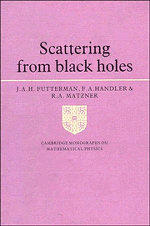Book contents
- Frontmatter
- Contents
- Acknowledgements
- Foreword
- 1 Introduction
- 2 Perturbations of black hole spacetimes
- 3 Integral spin plane waves in black hole spacetimes
- 4 Neutrino plane waves
- 5 Scattering
- 6 Limiting cross sections
- 7 Computation of cross sections
- 8 Absorption, phase shifts and cross sections for gravitational waves
- 9 Conclusion
- Appendix A1 Integrals used to express plane waves in terms of spin-weighted spheroidal functions
- Appendix A2 Addition formulae for spin-weighted spherical angular functions
- Appendix B
- References
- Index
7 - Computation of cross sections
Published online by Cambridge University Press: 04 August 2010
- Frontmatter
- Contents
- Acknowledgements
- Foreword
- 1 Introduction
- 2 Perturbations of black hole spacetimes
- 3 Integral spin plane waves in black hole spacetimes
- 4 Neutrino plane waves
- 5 Scattering
- 6 Limiting cross sections
- 7 Computation of cross sections
- 8 Absorption, phase shifts and cross sections for gravitational waves
- 9 Conclusion
- Appendix A1 Integrals used to express plane waves in terms of spin-weighted spheroidal functions
- Appendix A2 Addition formulae for spin-weighted spherical angular functions
- Appendix B
- References
- Index
Summary
We numerically calculate cross sections for gravitational waves axially incident on a Kerr black hole. The resulting detailed cross sections display a wealth of structure which can be linked conceptually to phenomena familiar from other scattering problems. The limiting cross sections in chapter 6 assist analysis by allowing truncation of numerical calculations where the limiting results become applicable and by pointing to parameter ranges of particular interest.
We examine the angular and radial equations in detail, finding in each case a form of the solution which allows efficient numerical integration. We consider two methods of solution for the angular equation; a perturbation calculation for insight and its continuation for the actual numerical work. For the radial equation, considered in the remainder of the chapter, we use a slow stable solution for small values of r and apply a JWKB approximation to integrate rapidly to large r.
Angular equation
We first consider the perturbation of the angular equation about aω = 0, where as before, a is the specific angular momentum and ω is the scattered wave frequency.
One reason for considering the perturbation calculation is that it lays the foundation for the actual method used. In particular we follow a technique of Press & Teukolsky (1973) to expand the spin-weighted spheroidal harmonics conveniently in the spin weighted spherical harmonics in both cases. The perturbation calculation only obtains spheroidal values to first or second order in aω. The continuation method utilizes the same expansion of the spheroidal functions, but finds expressions for their derivatives with respect to aω. The numerical solution then integrates these derivatives.
- Type
- Chapter
- Information
- Scattering from Black Holes , pp. 120 - 135Publisher: Cambridge University PressPrint publication year: 1988



